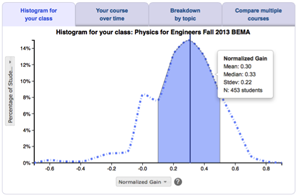Developed by: Danny Caballero, Rachel Pepper, Steve Pollock, and many others in the University of Colorado Boulder PER group and physics department




middle schoolhigh schoolintro collegeinter-mediateupper levelgrad school other





Overview
What? Supplementary activities for upper-level CM. Includes learning goals, interactive lectures, homework problems, student difficulties, tutorials, in-class group activities, and clicker questions. All materials are modular and can be mixed and matched with other teaching strategies or materials.
Student skills developed
- Conceptual understanding
- Problem-solving skills
- Using multiple representations
- Making real-world connections
- Metacognition
Instructor effort required
- Medium
Resources required
- TAs / LAs
- Clickers / polling method
- Projector
Resources
Teaching Materials
You can download all course materials for free, including lecture slides, clicker questions, homework, exams, and solutions from the developer's website on PhysPort.
Research
This is the third highest level of research validation, corresponding to:
- at least 1 of the "based on" categories
- at least 1 of the "demonstrated to improve" categories
- at least 1 of the "studied using" categories
Research Validation Summary
Based on Research Into:
- theories of how students learn
- student ideas about specific topics
Demonstrated to Improve:
- conceptual understanding
- problem-solving skills
- lab skills
- beliefs and attitudes
- attendance
- retention of students
- success of underrepresented groups
- performance in subsequent classes
Studied using:
- cycle of research and redevelopment
- student interviews
- classroom observations
- analysis of written work
- research at multiple institutions
- research by multiple groups
- peer-reviewed publication
References
- M. Caballero and S. Pollock, Assessing Student Learning in Middle-Division Classical Mechanics/Math Methods, presented at the Physics Education Research Conference 2013, Portland, OR, 2013.
- S. Pollock, R. Pepper, and A. Marino, Issues and Progress in Transforming a Middle-division Classical Mechanics/Math Methods Course, presented at the Physics Education Research Conference 2011, Omaha, Nebraska, 2011.




